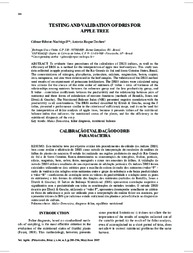Testing and validation of DRIS for apple tree.
Testing and validation of DRIS for apple tree.
Autoria: NACHTIGALL, G. R.; DECHEN, A. R.
Resumo: To evaluate three procedures of the calculation of DRIS indices, as well as the efficiency of DRIS as a method for the interpretation of apple tree leaf analyses. This study uses data collected in apple producing areas of the Rio Grande do Sul and Santa Catarina States, Brazil. The concentrations of nitrogen, phosphorus, potassium, calcium, magnesium, boron, copper, iron, manganese, and zinc were determined in the leaf samples. The validation of the DRIS method used results of an experiment of potassium fertilization. The DRIS indices were calculated using two criteria for the choice of the ratio order of nutrients (F value ? ratio of variance of the relationships among nutrients between the reference group and the low productivity group, and R value - correlation coefficients between the productivity and the relationship between pairs of nutrients) and three forms of calculation of nutrient functions (methods of Beaufils, Jones and Elwali & Gascho). The Nutritional Balance Index (NBI) presented negative correlation with the productivity in all combinations. The DRIS method described by Elwali & Gascho, using the F value, presented a performance similar to the criterion of sufficiency range, and it can be used for the interpretation of foliar analysis of apple trees, because it presents values of the nutritional balance index that indicates the nutritional status of the plants, and for the efficiency in the nutritional diagnosis of the crop. Key words: Malus Domestica, foliar diagnosis, nutritional balance
Ano de publicação: 2007
Tipo de publicação: Artigo de periódico
Unidade: Embrapa Uva e Vinho
Palavras-chave: DRIS, Doagnose foliar, Equilíbrio nutricional, Fruticultura, Maçã
Observações
1 - Por padrão são exibidas publicações dos últimos 20 anos. Para encontrar publicações mais antigas, configure o filtro ano de publicação, colocando o ano a partir do qual você deseja encontrar publicações. O filtro está na coluna da esquerda na busca acima.
2 - Para ler algumas publicações da Embrapa (apenas as que estão em formato ePub), é necessário ter, no celular ou computador, um desses softwares gratuitos. Sistemas Android: Google Play Livros; IOS: iBooks; Windows e Linux: software Calibre.
Acesse outras publicações
Acesse a Base de Dados da Pesquisa Agropecuária (BDPA) para consultar o acervo completo das bibliotecas da Embrapa.

